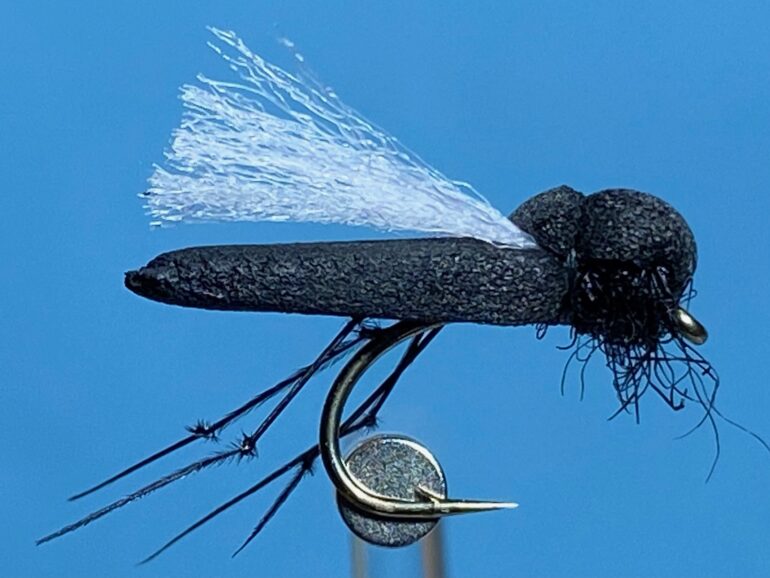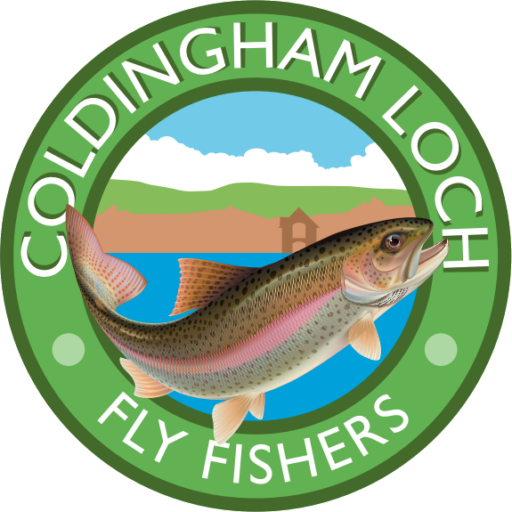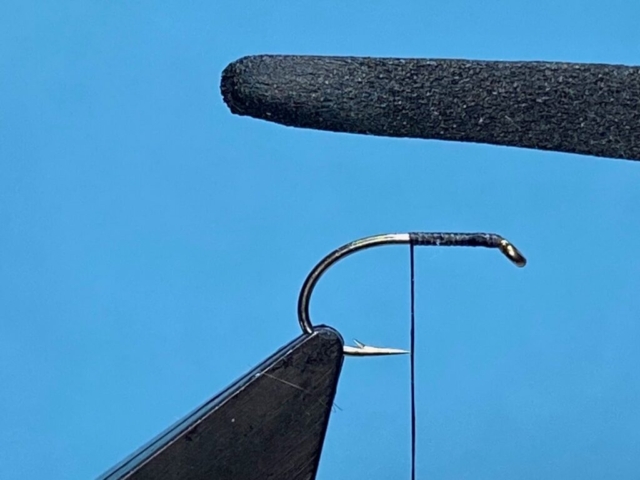
A Fly to Tie & Try for May by Les Lockey
Fly of the Month – May
Mike’s Dry Hawthorn
Hook: Kamasan B160, short shank hook, size 12.
Thread: Veevus GSP, 50D, black, or any fine black thread.
Legs: 4 knotted black pheasant tail fibres, tied trailing back.
Body: A strip of 2mm. black craft foam cut 3mm. wide and tapered at one end.
Wing: White Tiemco Aero Dry Wing.
Thorax: Black seal’s fur, or similar.
TYING
Photo 1. With the hook secured in the vice, start the thread behind the eye and wind on a bed of thread stopping opposite the hook point and remove the waste thread tag. From a piece of 2mm. thick craft foam, cut off a strip 3 mm. wide and pinch off one end to create a tapered end. Use a lighter to carefully flame the tapered end of the foam, then roll the foam between damp fingers to produce a smooth tapered finish. Set the foam strip aside for later.
Photo 2. Tie in 2 knotted pheasant tail fibre legs on each side of the hook shank to extend well beyond the bend of the hook. Remove the waste fibres.
Photo 3. For the abdomen, securely tie in the foam strip on top of the shank with the tapered end extending about 5mm beyond the bend of the hook. Continue to bind down the foam to immediately behind the hook eye and return the thread to the foam tie in point.
Photo 4. Take a length of white Aero Dry Wing, fold it in half, and tie it in as a wing over the top of the rearward facing foam. Bind down the butt ends to the hook eye with well waxed thread.
Photo 5. Dub some seal’s fur onto the thread and wind it on to form a tight, chunky thorax, leaving the thread at the base of the wing.
Photo 6. Under slight tension, pull the forward facing foam back over the top of the thorax and secure it in position with 2 turns of well waxed thread.
Photo 7. Add a drop of varnish or superglue to the thread and make a 3 turn whip finish through it and remove the thread. Cut off the excess foam thorax cover leaving a small foam stub. Finally trim the Aero Dry Wing the same length as the foam body and brush out a few strands of the seal’s fur thorax to complete the fly.
Tying Tips
- I find it best to prepare the detached foam bodies in batches. This speeds up the tying process and makes it easier to judge the amount of flame required to smooth the foam. Always keep your fingers wet when smoothing the heated foam to avoid burnt fingers.
- This is a simple fly to tie, but it is essential to make sure the foam body is securely tied down. To this end, well waxed thread helps greatly, but for a belt and braces approach, tie down the foam over a drop superglue.
- This pattern can be easily adapted to make an excellent Heather Fly imitation for use later in the season. Simply change the colour of the legs and the rear part of the thorax from black to red.
Fishing Hints
- In May ’22, my pal Mike Warburton and I had a great week’s dry fly fishing during regular falls of hawthorn flies, but on our last day, the detached foam bodied parachute pattern that had proved so successful all week seemed to lose its effectiveness, as the once confident and unmissable takes morphed into a variety of cautious, swirls and subtle sips, that proved almost impossible to convert into solid hook ups. This sent Mike rummaging through his fly boxes until he came up with this fly which immediately turned these half-hearted offers into solid hook ups. Just why this pattern succeeded when the charms of a previously very successful pattern had waned, I’m not sure. Perhaps this fly sits lower in the surface film, but it certainly produced the goods on the day, and importantly it is very easy to tie.
- Fish the fly singly on a floating line and strong leader and get ready for some explosive action.










Recent Comments